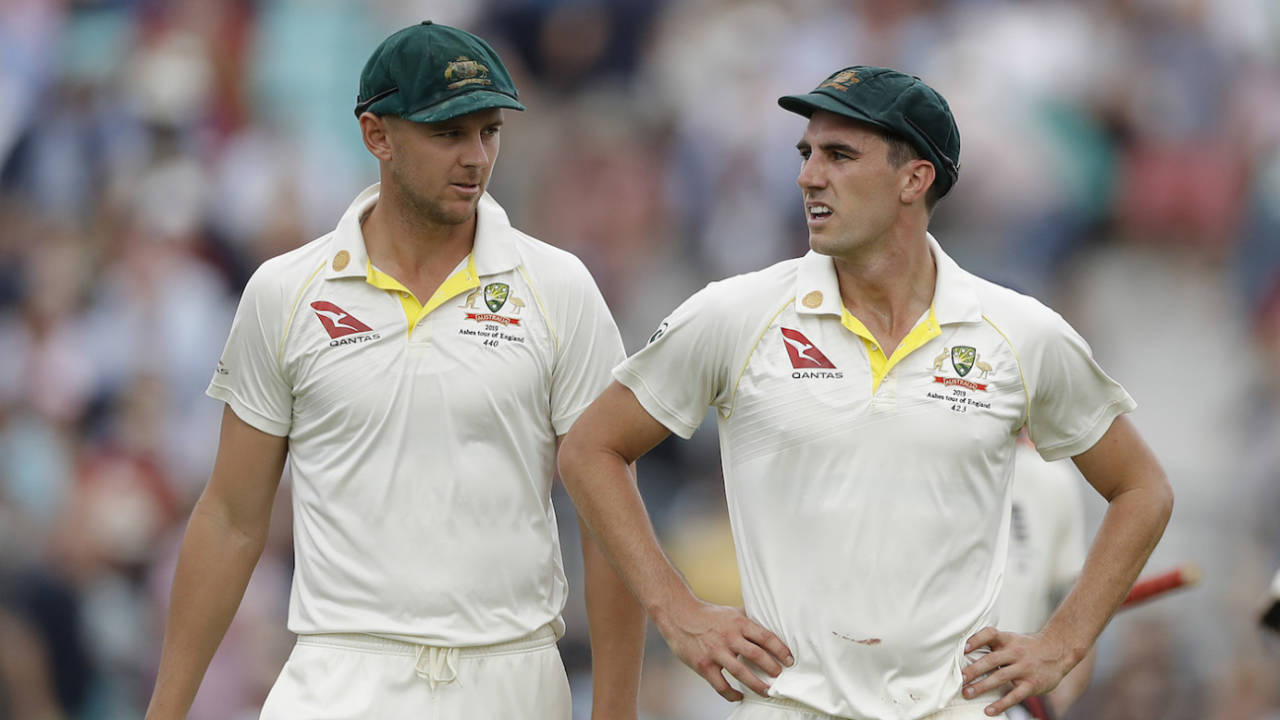The Ashes have shown again how important bowling pairs are in Tests
As Pat Cummins and Josh Hazlewood have proved, bowlers working in tandem can dramatically impact a series
Ian Chappell
15-Sep-2019
Josh Hazlewood and Pat Cummins have taken 47 wickets between them in the 2019 Ashes so far • Getty Images
As the Australian duo of Pat Cummins and Josh Hazlewood regularly scythe through the flimsy England batting line-up, it's a reminder of the dramatic effect talented bowling pairs have on Test matches.
Having been weaned on the outstanding fast bowling exploits of Ray Lindwall and Keith Miller, I was rudely awakened to the fact that Australia didn't have a monopoly on demoralising pace when Frank 'Typhoon' Tyson hit our shores in 1954-55. Teaming with the more clinical Brian Statham, Tyson demolished the Australian batting to claim 28 victims at the miserly average of 20.82. His achievement is even more remarkable when you realise he was clattered around the park to the tune of 1 for 160 off just 29 overs in the opening contest. Surely there cannot have been a more dramatic individual turnaround in a series.
In Test series dominated by bowling pairs, the trend is that once they gain a foothold, their dominance rapidly rises. We've seen it with Cummins and Hazlewood once their combination clicked, after Australia unwisely delayed Hazlewood's arrival until the second Test.
Although the Test records are full of many great fast-bowling duos - Wes Hall and Charlie Griffith; Andy Roberts and Michael Holding; Malcolm Marshall and Joel Garner, all from the West Indies; the dynamic Dennis Lillee and Jeff Thomson from Australia; and the more recent pairings of Englishmen Jimmy Anderson and Stuart Broad; and with perhaps the most unlikely combination, India's Jasprit Bumrah and Mohammed Shami - it shouldn't be forgotten that spinners can also play their part.
ALSO READ: Pat Cummins, Josh Hazlewood in rescue tandem
The most famous mixed combination, Glenn McGrath and Shane Warne, took an unbelievable 1000 wickets when playing together in Tests. That equates to 55% of the wickets taken by Australian bowlers in those matches.
Though many fans remember Richie Benaud only as an outstanding commentator, his legspin formed a destructive combination with opening bowler Alan Davidson in the late '50s and early '60s. They came to prominence in South Africa in 1957-58 when they took 55 wickets between them (Benaud 30 and Davidson 25), an incredible 62.5% of the wickets taken by Australian bowlers in that series.
Then there's the rare but equally demoralising effect of purely spin-bowling combinations, highlighted by India's talented triumvirate - Erapalli Prasanna, Bishan Bedi and Bhagwath Chandrasekhar - in the late '60s and early '70s. If opponents weren't dazzled by their subtle skills on the field, they were often tongue-tied when pronouncing their colourful names.
I've often pondered whether it isn't worse to be caught in a spinner's web than to be blasted out by a paceman. The former can be more embarrassing as it is usually eked out, while the latter is often a swift execution. Then there's the crowd's opinion: "Why can't he play the spinner? He's only bowling slow?"
In the case of Cummins and Hazlewood it hasn't been reliance on pure pace that makes them so effective but more subtle movement off the seam allied with relentless accuracy. Cummins has the added advantage of being able to switch to a short-pitched assault if nothing much is happening, and this threat is boosted by his admirable athleticism.
Although Hazlewood does occasionally unleash a well-directed bouncer, his general metronomic accuracy can lead to the odd problem with adventurous batsmen. This was evident in Ben Stokes' belated assault at Headingley and Jos Buttler's foray into one-day mode when he battered three sixes late on day one of the fifth Test.
The odd diversion shouldn't detract from the fact that between them this deadly duo have claimed more than 56% of the English wickets falling to Australian bowlers. Along with Steve Smith's supreme dominance with the bat, they are the reason Australia are (figuratively) carrying the urn back home.
Cummins and Hazlewood are a continuation of a trend that has been evident ever since fast men discovered overarm bowling.
Former Australia captain Ian Chappell is a a columnist
